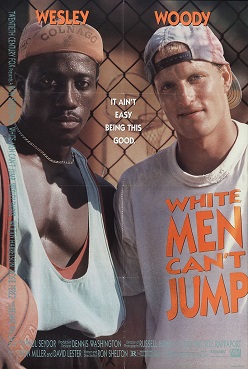Sports Movies are either a big miss or a SLAM DUNK for me. (I know I hate myself too).
But to be honest as I've grown up I've been able to identify that many sports movies are fine, but formulaic and terribly predicable. But that doesn't mean there haven't been good sports movies, many of my favorite movies growing up and still today are sports movies, I love the genre. A League of Their Own, Remember the Titans, Rudy, Hoosiers, Rocky 1-4 and 6 (and if anybody asks about Rocky 5, just say, "I don't know what you're talking about," and leave the conversation).

And I think I may have just added another one to that list, not to the one with Raging Bull and Hoosiers because it's not a feel-good inspirational flick or a hardcore drama. But I will add it to the list of sports films like The Sandlot and Caddyshack, because those movies and this have great memorable characters, have fun with their sport, and are great comedies.
White Men Can't Jump is the story of a white basketball hustler (Woody Harrelson) who cons people on the stereotype that white men can't play ball with black players. This catches the attention of Wesley Snipes who's a con-player himself, and the two team-up to double their hustles and their winnings. The best part about the movie is the witty dialogue and the chemistry between Snipes and Harrelson which is electric to watch. Snipes is so much fun to watch as the self-proclaimed and arrogant star of the Los Angeles outdoor hoops scene, and Harrelson is just as fun as the self-righteous yet equally stubborn athlete. The plot is great too by taking the normal sports genre formula and not going exactly by the book. There's double crosses between the two supposed friends, there's real stakes that you can feel, and it doesn't have an entirely satisfying big insertional ending that many people come to expect out of the genre. And this movie by far has the creative and funny trash-talk of any sports movie. Ever. With great lines like, "Oh man shut your anorexic malnutrition tapeworm-having overdose on Dick Gregory Bahamian diet-drinking ass up," and, "Yo mother is so stupid. It would take her 1, no. 2 hours to watch 60 MINUTES!" This is by far one of the funniest sports movies I've ever seen, and its got some of the most fun and engaging characters and clever scripts I've seen in a while from any film. Although something does happens that drags the movie in the second act, and although the ending isn't completely satisfying (which is cool for once), it also isn't fully realized and the film doesn't exactly finish with the same energy and verve it started with. But these things still can't detract from White Men Can't Jump being one of the best sports movies I've seen in the past few years. It's got great writing, characters, and some pretty compelling basketball scenes using long and wide shots to show the skill of the players and to see the full action of their pickup games. Overall, I had a ton of fun with this movie and I give it 4/5 stars.





